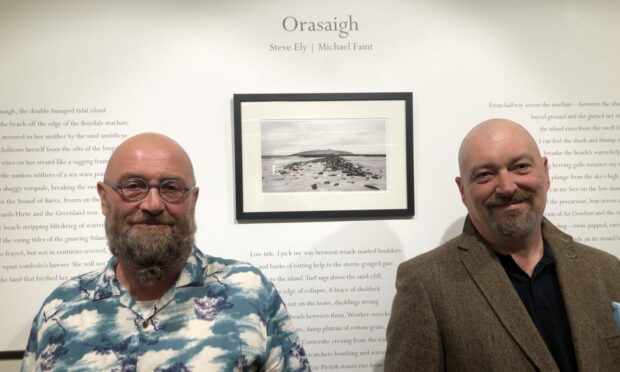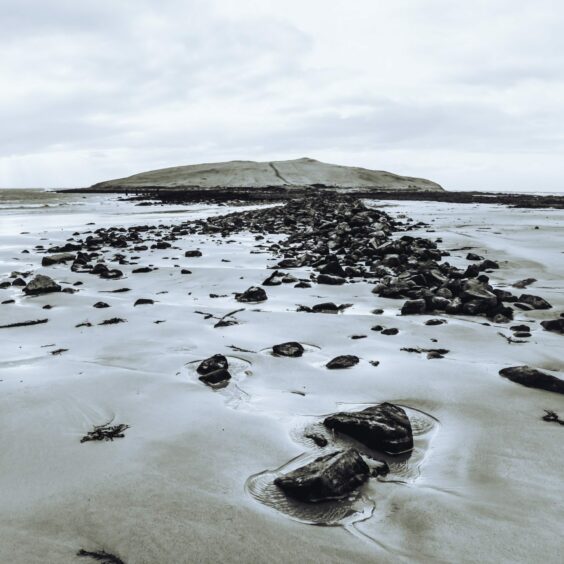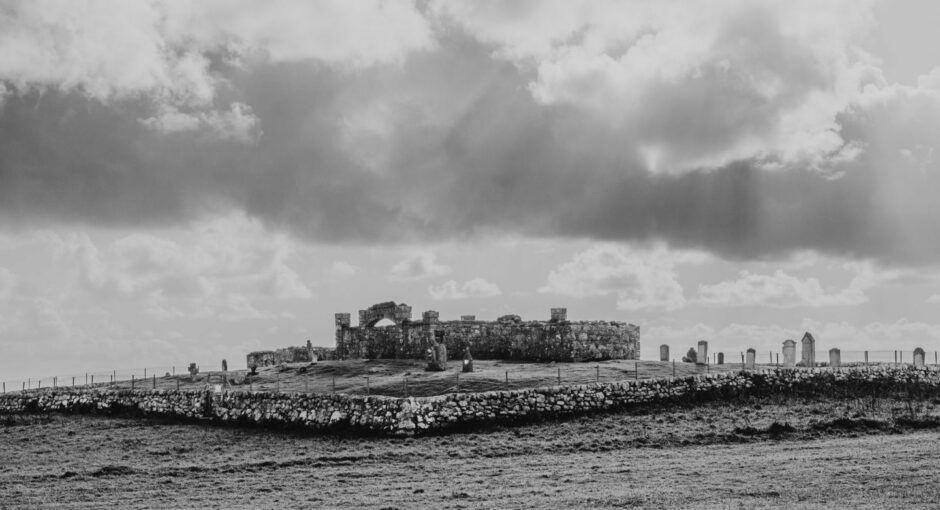In the exhibition and upcoming book Orasaigh, poet Stephen Ely and photographer Michael Faint use a single island to examine everything from archaeology to politics.
It can be easy to pass by Uist’s many small, uninhabited islands without thinking about the story behind them.
But South Uist’s Orasaigh – a name simply meaning ‘tidal island’ – has stepped into the spotlight in an exhibition touring Uist.
The exhibition, called simply Orasaigh, features a single long poem by Stephen Ely and photography by Michael Faint.
It first opened in South Uist’s Cnoc Soilleir building and will be coming to North Uist’s Taigh Chearsabhagh arts centre in November.
Poet Stephen Ely is based in Yorkshire, where he teaches at the University of Huddersfield.
For “maybe 15 years”, however, he has regularly made the journey up north to spend time in Uist.
“I usually stay in the same cottage, and Orasaigh, the island, is right behind it, right on the coast,” he says.
‘I’ve spent a lot of time wandering around the island’
Orasaigh is a small tidal island off the coast of South Uist. Like so much of Uist’s landscape, it has a rich history that is still being discovered by archaeologists.
In 2019, Stephen came up to the islands with a purpose.
“I was writing a poem called The European Eel,” he says. “My plan was to walk during the day and write in the evenings, but whenever I sat down to write, I couldn’t.”
Instead – and to his surprise – he found his creative mind drifting to the tiny island that he had been holidaying next to for so many years.
“It just kept forcing its way into my consciousness,” he says.
“I’ve spent a lot of time wandering around the island and the neighbouring beach. I’ve seen a range of phenomenal wildlife on it. I’d spent several lazy afternoons just lounging about on the grassy slope at the back of the island, gazing out across the ocean.”
“I can see with hindsight that, over the years, the island had somehow become meaningful to me.”
However, he had made a pact with himself: “I’m not going to start writing a new poem.”
But as Orasaigh clearly wasn’t going to leave his mind, he needed to find a solution.
“I told myself, ‘it clearly wants to be written about, so I’ll spend an evening brainstorming everything that I know about it’.”
At the end of that evening, he had pages full of notes. “And I was then able to write The European Eel,” he says.
But his poem Orasaigh waited patiently in the background.
‘Some of Michael’s photos looked like they were poems already’
In fact, it ended up being long enough to be a book on its own. But along with the text, Stephen wanted there to be a visual element.
Once he found Michael Faint, a photographer working in Uist who has done work for Cnoc Soilleir in the past, he knew he was “the obvious choice”.
“Some of the photos on his website looked like they were poems already.”
‘A deeper visual element’
Michael says he was immediately “intrigued” when Stephen first approached him.
Through his photography, he worked to bring “a deeper visual element to the poem, and therefore another layer of storytelling to the collaboration.”
“Intentionally, many of the photographs are a very literal and recognisable representation of the words of the poem while others are an expansive interpretation of the underlying themes,” he says.
For Michael, every look into the poem brought something new.
“By reading and re-reading the poem I was able to imagine further images I would like to bring to the text,” he says.
“Of course, the landscape, weather, wildlife (and especially the ravens) can have their own ideas around these plans, so I have to adapt and create images with what I am given on the day.”
The book is due to come out in August 2024.
More local reporting from the Western Isles:
- ‘Pulse of the landscape’: North Uist artistic collective celebrates latest exhibition amid fight for island’s art course
- Pilot makes safe landing after plane is struck by lightning just before arriving in Stornoway
- ‘Raucous crowds’: Tourists still camping in Western Isles cemetery car parks almost a year after ban was agreed, islanders say



Conversation